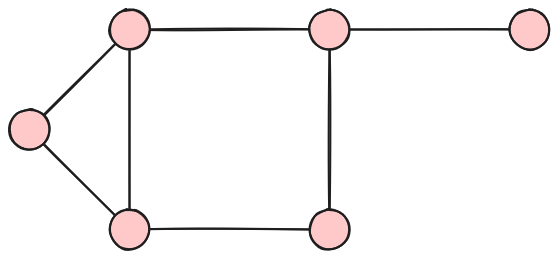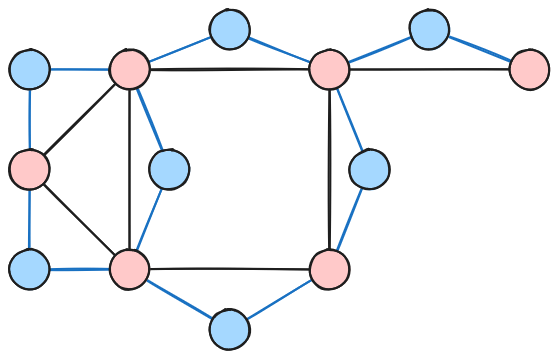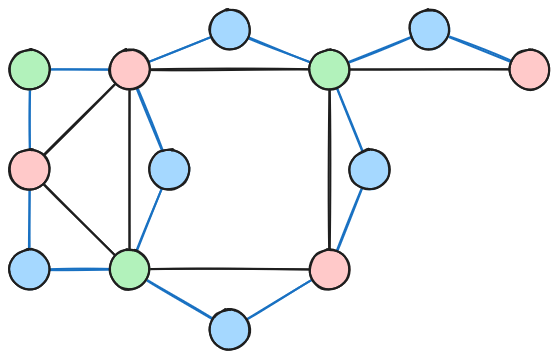Example Graph

Example Graph

Dominating Set is NP
- Given a set of vertices
- Check for every vertex in the original graph if it is in
- If it is not, check each of its neighbors
- Time Complexity:
Dominating Set is NP-Hard
- Use the unknown to solve the known!
- Unknown: Dominating Set
- Known: ... ?
- Identifying the problem which performs the best reduction
- Takes experience to be able to do so effectively
- An attempt for the thought process you may have
- Graph Problems
- Independent Set
- Vertex Cover
- 3 Coloring
- Other Problems
- Are we minimizing or maximizing in dominating set?
- Minimizing!
- Not a hard and fast rule, but perhaps a hint
Dominating Set -> Independent Set

- Getting rid of the additional vertex may be tricky
- Potentially dealing with cliques
- Overall getting messy
Dominating Set -> Vertex Cover

- Optimizations are aligned
- Recall for every edge, an adjacent vertex must be in the cover
- What if we made the edges vertices as well?
Dominating Set -> Vertex Cover
- Process:
- For every edge add a new vertex called
- Connect this new vertex to vertices and
- Find a dominating set of size
Dominating Set -> Vertex Cover

Dominating Set -> Vertex Cover

Algorithm Will Find Vertex Cover
- Let us decipher the output of the algorithm
- Dominating set picks a set of vertices adjacent to all other vertices
- Edges now have a vertex representitive
- All edges are either adjacent to a vertex or "they" were picked
- Some intuition, but now we must prove it
No False Positives
- Prove: The algorithm finds a valid vertex cover of size
- For each "edge" picked, pick either adjacent vertex
- For every edge in the graph, there must be either or in the picked set
No False Negatives
- Prove: If there is a vertex cover of size a dominating set of size must also exist
- Take the vertex cover of the initial graph of size
- In the corresponding modified graph, it is also a dominating set
- Every vertex cover is also a dominating set
- Adding the extra edges does not affect the domination in any way
0-1 Knapsack
- A backpack can carry weight
- There is set of items to take
- Each item has a weight and benefit value
- Goal: select a subset of the items such that
- Total weight is at most
- Maximizing total benefit of the items
Isn't That Strange?
- But we have a solution of ?
- This actually doesn't count because of the
- can actually be massive and completely screw up the time complexity
0-1 Knapsack is NP
- Is this true?
- No
- How do we know that this is actually the largest?
- We can modify this to be
- Is there a set of items that have a benefit of and under ?
- Now is this NP?
0-1 Knapsack is NP-Hard
- Use the unknown to solve the known
- Unknown: 0-1 Knapsack
- Known: Subset Sum
- This one is a bit obvious, hopefully?
0-1 Knapsack -> Subset Sum
- How should we solve Subset Sum with 0-1 Knapsack?
- Take each number in Subset Sum, convert to item
- Benefit: number
- Weight: 1
- Set the max weight to be the total number of elements (or )
- Set benefit target as the target from Subset Sum
Proof
- Hopefully the proof is intuitive, but we do need to go through the motions
- No False Positives: Summation of elements is which is the target for Subset Sum
- No False Negatives: Solution for Subset Sum would work for Knapsack
Clustering Problem
- Given a weighted graph an integer and a target
divide the vertices into sets
- Any pair of nodes in the same set should have a shortest path length of
- Is this problem NP-Complete?
Clustering is in NP
- Given an assignment of clusters
- Make sure there are of them
- For every pair of vertices in a cluster, verify the shortest path is at most
- How many pairs of vertices are there?
- Upper bound on ?
- Takes at most
Clustering is NP-Hard
- Use the unknown to solve the known!
- Unknown: Clustering
- Known: ... ?
- Another attempt at some problem solving
- Graph Problems
- Independent Set
- Vertex Cover
- Dominating Set
- 3 Coloring
- Other Problems
Some Thought Processes
- Independent Set, Vertex Cover, Dominating Set
- All structurally similar, but the value is hard to translate
- Let's look at 3-Coloring instead
Some Thought Process
- We know that 3-Coloring is grouping vertices into 3 sets
- Trying to find a valid grouping, similar to clustering
- would be
- How would the weights factor in?
- Use the weights as a way to keep the adjacent nodes in separate sets
Clustering -> 3-Color
- Create a new weighted graph with the same vertices, but is a complete graph
- All edges in the original graph have a weight of 2
- All other edges have a weight of 1
- Set and
Deciphering the Output
- Every adjacent node has a weight of 2, automatically exceeding the target
- Any alternate path will also be at least 2
- Prevents adjacent nodes from being in the same cluster
- Now we must prove that this holds
No False Positives
- Suppose there is a cluster that does not translate to a coloring
- Means there are two adjacent nodes in the same clustering
- But this is impossible, as the shortest distance must be 2
- Contradiction!
No False Negatives
- Suppose there is a 3 coloring that does not translate to a clustering
- Means 2 vertices have the same color, but shortest distance is 2
- Same color means non adjacent
- Graph is set up to create an edge of weight 1 if they are not adjacent
- Contradiction!





